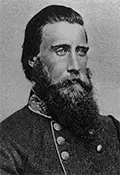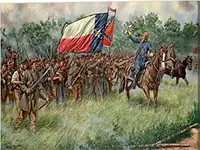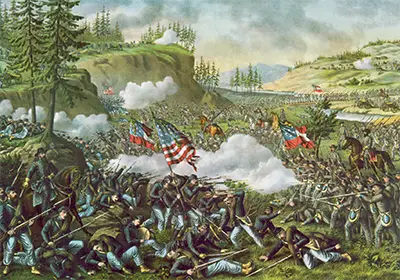Confederate General John Bell Hood
John Bell Hood was a Confederate general during the American Civil War. He was known for his aggressive tactics, which succeeded early in the war but ultimately led to later defeats. He was born in 1831 at Owingsville, Ky. His date of birth is listed as June; sources differ on the exact date. 
Young John was enchanted by the feats of his grandfather, Lucas Hood, who had served with Maj. Gen. "Mad" Anthony Wayne at the Battle of Fallen Timbers in 1794. Against his parents' wishes, John enrolled at the U.S. Military Academy in 1849. He graduated four years later and reported for an assignment in California. Hood saw action in Texas as part of the 2nd U.S. Cavalry, and sustained a hand injury during a Comanche attack near Devil's River. In 1858, he was offered a return to West Point, as Chief Instructor of Cavalry, but declined. 
When the Civil War began, he resigned his commission in the U.S. Army and joined the Confederate Army. His home state, Kentucky, was still in the Union, so Hood adopted Texas as his home state during the war. He won appointment as colonel of a Texas infantry outfit in 1861. He worked his way up the ladder, earning command of the Texas Brigade in 1862 and a promotion to brigadier general. Hood and his men joined Gen. Joseph Johnston's Army of Northern Virginia and fought at the Battle of Seven Pines. Johnston, wounded in the battle, left the front and was replaced by Robert E. Lee. Hood proved just as aggressive as Lee, leading a decisive charge during the Battle of Gaines' Mill, as part of the Battle of the 7 Days. Hood proved himself an able commander again at the Second Battle of Bull Run, helping dissolve the left flank of Maj. Gen. John Pope and send the Union army into retreat. Lee counted on Hood to continue his brilliance on the battlefield, and the Kentuckian did not disappoint. He held the line at Turner's Gap during the Battle of South Mountain, enabling the rest of Lee's men to retreat to Sharpsburg; then, at that battle, he shored up the Confederate left and turned the tables on the Union with a fierce counterattack. Hood and his men were at Fredericksburg during the battle there but saw little action. They accompanied Maj. Gen. James Longstreet on patrol and so missed the Battle of Chancellorsville. During the epic Battle of Gettysburg, Hood led an advance on the Union left flank that resulted in a severe wound to his left arm. He avoided amputation but had sparing use of the arm thereafter. 
After recuperating in Richmond, Hood rejoined Longstreet's men just as they were joining the Army of Tennessee, led by Gen. Braxton Bragg. Hood played a major part in the Confederate victory at Chickamauga. In that battle, he again suffered serious injury; this time, the wound was in his right thigh and required partial amputation of the leg. He returned to Richmond to recover and was promoted to lieutenant general. He returned to combat in 1864, as part of the defense of Atlanta from the advance of Maj. Gen. William T. Sherman. Leading that defense was Johnston, Hood's earlier commander. Hood wrote to his friend Jefferson Davis, the president of the Confederacy, complaining of Johnston's lack of aggression. Davis relieved Johnston of his overall command and installed Hood in his place as head of the Army of Tennessee, along with promotion of the rank of general. At 33, he was the youngest army commander in the entire war. On July 20, three days after his elevation, he engaged Union troops at the Battle of Peachtree Creek; the result was a Union victory. More Union victories followed, as Hood's aggressive tactics delivered few dividends and no victories. He abandoned Atlanta on September 2. Hood took his men north into Tennessee, hoping to convince Sherman to abandon his "March to the Sea" and come back west; Sherman continued eastward. Hood and his men found defeat at the Battle of Franklin on Nov. 30, 1864 and then again at Nashville, on December 15 and 16. He asked to be relieved of his command on Jan. 23, 1865. He remained a lieutenant general. Davis sent Hood to Texas with orders to raise a new army. However, both Davis and Texas soon surrendered. Hood turned himself in to Union forces at Natchez, Miss., on May 31, 1865. He found work in the private sector after the war, serving in the insurance business and buying and selling cotton. In 1868, he married Anna Marie Hennen; they had 11 children. He died on Aug. 30, 1879, of yellow fever. |
|
Social Studies for Kids
copyright 2002–2024
David White




